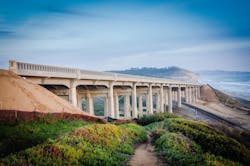No. 4 - North Torrey Pines Road Bridge
The North Torrey Pines Road Bridge, built in 1933, was classified as structurally and seismically deficient in 1990, receiving a sufficiency rating of only 19 out of 100. To extend the bridge and bring it up to current seismic standards, the design, engineering and construction teams had to contend with long-standing deterioration, structural irregularities, space constraints and the site’s irregular soil. In addition, this bridge is a designated historic site in the National Register of Historic Places, which further restricted the project.
Initial analyses showed that the majority of the bents and abutments were not connected to the structure appropriately, and even if they had been, the columns would not be able to handle the seismic demands without catastrophic failure.
The plan to handle all of these problems was to isolate the superstructure from some of the existing columns, thereby pre-stressing the entire superstructure for continuity.
“The solution was a performance-based seismic design methodology . . . which led to a unique multifaceted retrofit and rehabilitation approach,” Mark Creveling, P.E., of Kleinfelder told Roads & Bridges.
To begin the rehabilitation, Kleinfelder and the construction team had to stabilize the soil beneath the bridge using ground improvement, which involved the injection of 700 yd of grout into 533 holes in the ground.
Then, a series of deep-foundation abutments were installed to further stabilize the structure, along with shear reinforcement, retrofitting on the columns and the addition of below-grade bent shear walls. Corrosion was a serious problem, resulting in the installation of a cathodic protection system of mesh and anodes within the bents and of a deep well anode below ground.
The bridge had to remain open during construction. To make this possible, the engineering and construction teams developed a temporary bridge widening system. New bicycle lanes and traffic-control systems were required. On the east side of the bridge, temporary structures diverted traffic while the west side was retrofitted, their placement then reversed; these structures were shifted to the west side when retrofitting began on the east.
“The selected alternative of replacing the superstructure and repairing the substructure was the most sensitive solution to the environmental and historic challenges that was able to achieve required service life and seismic performance,” said Creveling. “In addition, the unique approach was the least impactive to the environmental setting of sensitive species and habitat, wetlands, recreational uses and coastal considerations.” R&B
